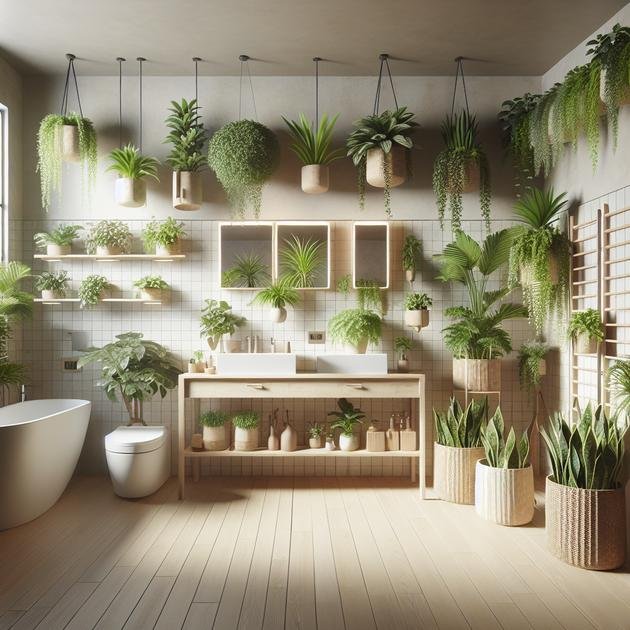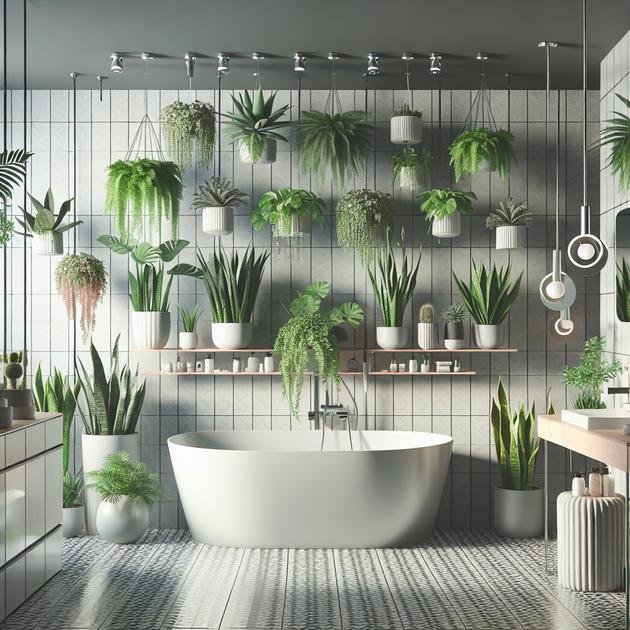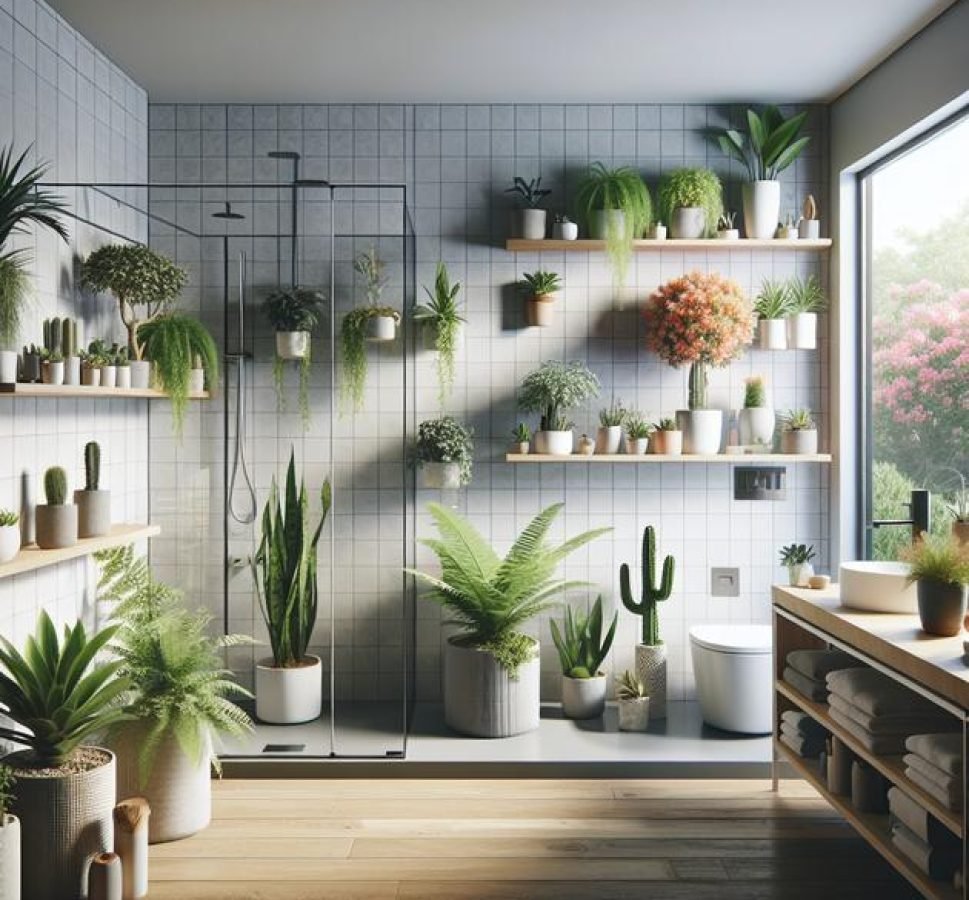Bathroom plant ideas transform your space by choosing humidity-loving plants like ferns, utilizing vertical gardens for small areas, and ensuring air-purifying options like snake plants improve both decor and indoor air quality.
Bathroom plant ideas can truly transform your space! Imagine a lush oasis right where you start your day, making routines a bit more invigorating.
choosing low-light plants
When selecting plants for a bathroom, low-light plants are your best friends. These plants thrive in environments with minimal sunlight, making them perfect for bathrooms with small or frosted windows. Consider adding plants like snake plant, pothos, or ZZ plant, all of which are well-known for their ability to survive in low-light conditions.
Caring for Your Low-Light Plants
Despite being low-light, these plants require some attention. Ensure your plants are in a spot where they can receive whatever light is available, and remember to rotate them regularly to maintain balanced growth. Watering needs vary, but a general rule is to water when the top inch of soil feels dry.
Bathrooms typically have higher humidity levels, which these plants love. However, ensure proper drainage to prevent root rot. Periodically, wipe the leaves with a damp cloth to remove dust and allow them to absorb light efficiently.
Benefits of Low-Light Plants
Besides being easy to care for, these plants can improve indoor air quality and bring a natural touch to your space. Their greenery can create a soothing atmosphere that enhances relaxation, turning your bathroom into a calming retreat.
best plants for humidity
Bathrooms provide a humid environment perfect for certain houseplants that thrive in moisture-rich air. Some of the best plants for humidity include the Boston fern, spider plant, and peace lily. These plants flourish in the steamy atmosphere of a bathroom, making them excellent choices for enhancing your space.
Boston Fern
The Boston fern loves humidity and can turn your bathroom into a green oasis. It requires indirect light and consistently moist soil, making it a perfect plant for this setting.
Spider Plant
Easily recognizable by its arching leaves, the spider plant adapts well to bathroom conditions. It tolerates different light levels and benefits from the room’s high humidity, which keeps it lush and healthy.
Peace Lily
Known for its elegant white blooms, the peace lily thrives in dim, humid conditions. It purifies the air and adds a touch of sophistication. Ensure the soil remains moist but not waterlogged for optimal growth.
maintenance tips for bathroom plants
Keeping bathroom plants healthy involves simple yet effective maintenance practices. Start by considering the light conditions. Most bathroom plants thrive in low to medium light, so place them near windows or in areas with indirect sunlight. Ensure your plants receive the appropriate amount of light, as it prevents leggy growth and promotes vibrant foliage.
Watering Techniques
Bathrooms can be humid, which might reduce the need for frequent watering. Check the soil moisture by touching the top inch of the soil—if it’s dry, it’s time to water. Use room temperature water to avoid shocking the roots. Overwatering can be a common mistake, so be cautious about waterlogged soil.
Humidity and Air Circulation
The natural humidity in bathrooms is beneficial for many plants. However, good air circulation is equally important to prevent mold and mildew. If your bathroom lacks airflow, consider using a small fan or occasionally opening the windows.
Additionally, cleaning the leaves of your plants helps them absorb light better. Use a damp cloth to gently wipe down the foliage, removing dust and debris. This not only keeps the plants looking fresh but also allows them to breathe more effectively.
how to arrange plants in small bathrooms

Arranging plants in small bathrooms can enhance the space without making it feel cluttered. Start by using vertical space efficiently. Consider installing shelves or using hanging planters to display your favorite greenery. This approach allows you to enjoy the lush beauty of plants without sacrificing valuable floor space.
Strategic Placement
Position plants around windows or mirrors to maximize light exposure. This not only helps the plants thrive but also adds a touch of nature to reflective surfaces, creating an illusion of more space. Select a mix of trailing and upright plants to add depth and visual interest.
Choose compact pots and containers to maintain a neat appearance. Consider using wall-mounted planters that can hold small succulents or herbs, making excellent use of blank wall areas. Grouping plants with similar care needs will facilitate easier maintenance and ensure each plant flourishes.
Creative Space Utilization
Utilize corners by placing tall plants like ferns or snake plants that can grow upwards without spreading outwards too much. Use the top of a toilet tank for smaller plants in pretty pots to add greenery without overcrowding. Be creative with your arrangement to ensure every plant receives adequate light and care.
budget-friendly plant decor
Enhancing your bathroom with budget-friendly plant décor is easier than you might think. Start by selecting plants that are cost-effective yet visually appealing, such as succulents and baby’s tears. These plants not only add green charm but also require minimal care, keeping costs down.
Creative Potting Solutions
Repurpose household items as plant containers to save money. Teacups, tin cans, or glass jars make excellent pots and add a unique touch to your décor. Decorating these containers with paint or ribbon can personalize them further, creating a cohesive look.
Walls are often overlooked but can be a prime location for plant decor. Use floating shelves that you can make yourself or purchase inexpensively. Arrange small pots on these shelves to maximize vertical space without crowding the room.
DIY Enhancements
Consider making your own macramé plant hangers. These hangers are stylish and an affordable way to display your plants at varying heights, adding depth and interest. Simple online tutorials can guide you through creating these hangers with inexpensive materials.
picking pots that complement your bathroom
Selecting the right pots for your bathroom plants can enhance the overall aesthetic of your space. Consider materials like ceramic, glass, or metal that match the bathroom’s decor. A ceramic pot with a glossy finish can add elegance, while a textured metal pot could bring a modern touch. The key is to ensure the pots harmonize with existing fixtures like faucets or mirrors.
Color Coordination
Color plays an important role in achieving a coherent look. Opt for neutral tones if you want the plants to stand out, or choose pots with vibrant colors to create a focal point. Matching the pot’s color with bathroom accessories like towels or shower curtains can tie the entire space together.
For a playful vibe, mix different patterns and colors while ensuring they complement each other. If you prefer a minimalist look, stick to monochrome pots but vary the textures—perhaps a matte alongside a shiny finish—to add subtle interest.
Size and Scale
The size of the pot should correspond to the plant it holds and the space available. Small bathrooms benefit from compact pots that don’t obstruct movement or visual flow. Consider using tiered shelving to place multiple small pots, providing height and depth without taking up counter space.
common mistakes to avoid
When decorating with plants in the bathroom, it’s easy to make a few common mistakes that can affect the health of your greenery. One common error is choosing plants that require more light than your bathroom can provide. Always opt for species suited to low-light conditions like ferns or snake plants.
Overwatering
Bathrooms are naturally humid, thus overwatering is a frequent mistake. The excess moisture in the air means plants often require less water than in other parts of the house. Feel the soil before watering to ensure it needs more moisture.
Avoid using pots without drainage holes. Without proper drainage, water can accumulate at the bottom of the pot, leading to root rot. Ensure all pots have at least one drainage hole and consider using a pebble tray to catch excess water.
Neglecting Air Circulation
Another mistake is forgetting about air circulation. Plants need fresh air to thrive, yet bathrooms can be stuffy. Keep doors open or install a small fan to ensure airflow. This will prevent mold growth on both the plants and walls.
seasonal care for bathroom plants

Providing the right seasonal care for your bathroom plants can enhance their growth and longevity. In spring and summer, when growth often accelerates, increase watering but ensure the soil has proper drainage. Consider using fertilizer sparingly to boost the plants’ nutrient intake.
Autumn Adjustments
As fall approaches, gradually reduce watering since many plants enter a dormant phase. Check the humidity levels in your bathroom and, if necessary, consider adding a small humidifier to compensate for drier air.
During winter, focus on maintaining a stable environment. Lighting can be a challenge with shorter days, so place plants closer to windows or supplement with a grow light. Also, be mindful of temperature drops that can affect sensitive plants.
Year-Round Tips
Regardless of the season, regular leaf cleaning can help plants make the most of available light. Use a damp cloth to gently wipe leaves, preventing dust buildup. Monitoring your plants’ specific needs throughout the year ensures they remain vibrant and healthy.
creating a spa atmosphere
Transforming your bathroom into a spa atmosphere can be achieved with thoughtful plant placement and complementary decor. Start by selecting soothing plants like lavender, eucalyptus, and aloe vera. These not only add a calming green touch but also provide aromatherapy benefits.
Ambient Lighting
Use soft, ambient lighting to create a relaxing mood. Consider adding LED candles or string lights around the bathroom, which can complement the natural beauty of the plants. These subtle light sources enhance a tranquil environment without overpowering.
Incorporate natural elements like bamboo or stone to accent the plants. Bamboo can be used for shelving or as a plant itself, while smooth stones make excellent decorative pieces, enhancing the overall peaceful vibe of the space.
Texture and Scent
Introduce textures through plush towels and mats to heighten the spa-like feel. Choose neutral or earth tones to keep the focus on the lush greenery. Adding essential oil diffusers will distribute calming scents, blending seamlessly with the aromatic plants.
incorporating vertical gardens
Incorporating vertical gardens into your bathroom can maximize space and bring a lush, vibrant feel to the area. These gardens are ideal for small bathrooms where floor space is limited. Use wall-mounted planters or hanging pots to create an eye-catching focal point.
Plant Selection
Choose plants that thrive in vertical arrangements and require minimal soil. Ferns, ivy, and air plants are excellent options as they grow well when mounted. These plants also enhance air quality, making them both practical and beautiful additions.
Arrange your plants in layers or patterns to add depth and texture to the walls. Consider a mixture of greenery and blooming plants for a splash of color. Ensure they receive adequate light to keep the display lush.
Installation Tips
Securely attach planters to the wall with sturdy hooks or brackets. Waterproof backings are essential to protect walls from moisture. Use lightweight materials for planters to avoid putting too much strain on the walls.
using plants to enhance air quality
Using plants to enhance air quality in your bathroom is both a decorative and functional choice. Certain plants are known for their ability to purify the air by removing toxins and increasing humidity. Consider incorporating peace lilies, snake plants, and spider plants for their effectiveness.
Benefits of Air-Filtering Plants
Peace lilies actively absorb pollutants like ammonia and formaldehyde, making them excellent air purifiers. Snake plants perform a unique function by converting CO2 into oxygen at night, which is beneficial for improving air quality even in low-light conditions.
Spider plants are also remarkable for their purification capabilities, removing substances like benzene and xylene. These plants are easy to maintain, making them ideal for bathroom environments.
Placement Tips
To maximize the air-purifying effects, place these plants near windows or vents where air circulation can aid the process. Ensure they have room to grow and aren’t overcrowding other decor. Regularly dust leaves to prevent buildup and maintain their efficiency in filtering air.
Bringing Your Bathroom to Life with Plants
Transforming your bathroom into a vibrant oasis through plants is both an art and a science. From choosing low-light options to creating vertical gardens, each element adds a touch of nature that enhances the space. More than just decoration, these plants offer air purification and a sense of tranquility.
Start by selecting the right plants for your environment, ensuring they match your lighting and space needs. Be mindful of common pitfalls such as overwatering and inadequate drainage, and embrace creative pot choices that complement your decor.
Whether crafting a budget-friendly setup or designing a spa-like retreat, the possibilities with bathroom plant decor are endless. Incorporate these ideas to create a refreshing, clean, and nature-inspired atmosphere that’s sure to elevate your daily routine.





